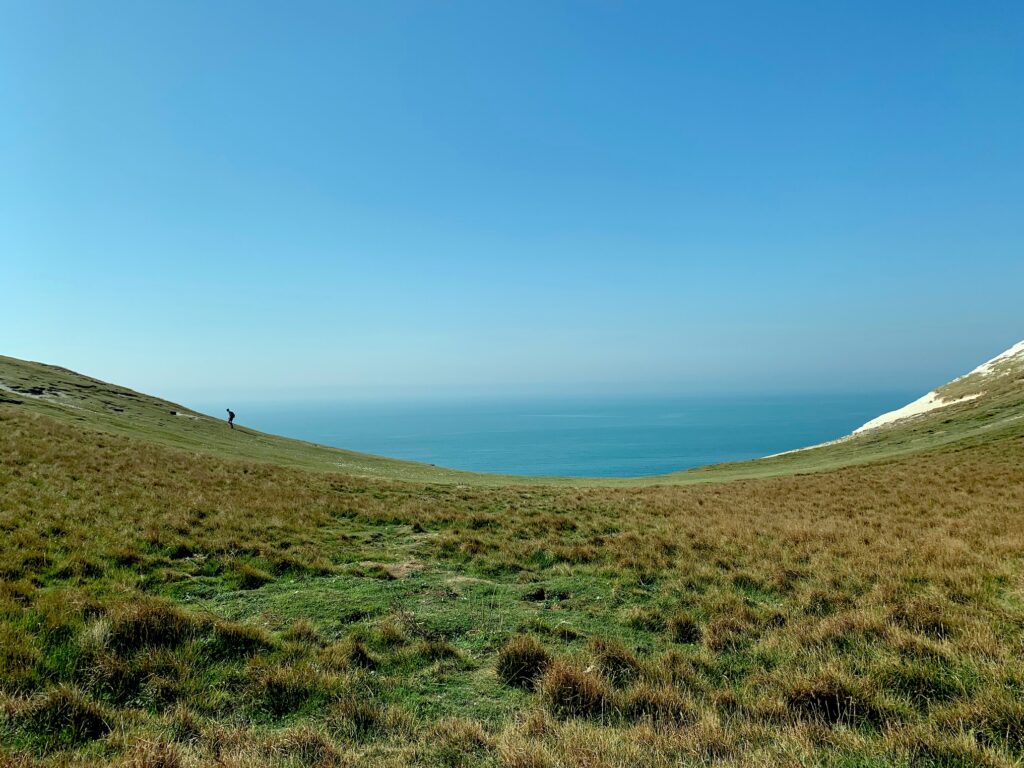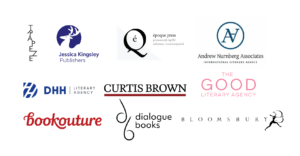I‘ve spent much of my professional life as an artist working in visual media, but writing has always been with me in some form, before I ‘became’ a writer.
Texts, and in particular reading poetry were an early part of my process of conjuring new ideas; picking out a Rumi verse at random to guide and crystallise ideas became a regular strategy, right from my first public installation, Space within the Real. Next, it was a book, Sadie Plant’s Zeros and Ones, which rewrites the role of women in the history of computing via weaving through a feminist lens, which opened up the rich, historical connections between text, textile and technology and inspired me to begin embedding texts directly into spaces or material surfaces – and inviting others in, to do the same. This became my installation language, initially in The Loom: from text to textile, weaving together narratives of birth and death, through the computer-mediated weaving of contributed data from the public into a 20 metre textile.
Written provocations of a more political nature have also played an important part in my creative process of engaging others in thorny subjects which have deeply affected me, such as the power of debt, in Burning the Books, a touring performance inviting the public to write, co-recite and burn hundreds of debts and their backstories together in nine cities across the UK.
Personal stories and their fictionalised echoes, often beginning with my own, have acted as a bridge for others to enter the work, either verbally as part of the production process, as in my short film on British-Iranian identity, 1+1=3 or en masse, for example in the co-created installation, The Gifts ; 999 objects representing a loss or ending ,wrapped in textile and displayed with personal texts by those who donated them.
Following the death of my mother in the 2004 Boxing Day tsunami, this process became even more haptic as I created a collection of sculptures from some of her most personal belongings, wrapping them in fabric and binding them in handwritten texts; poetry, lyrics and my own diary entries from the immediate weeks following her death.
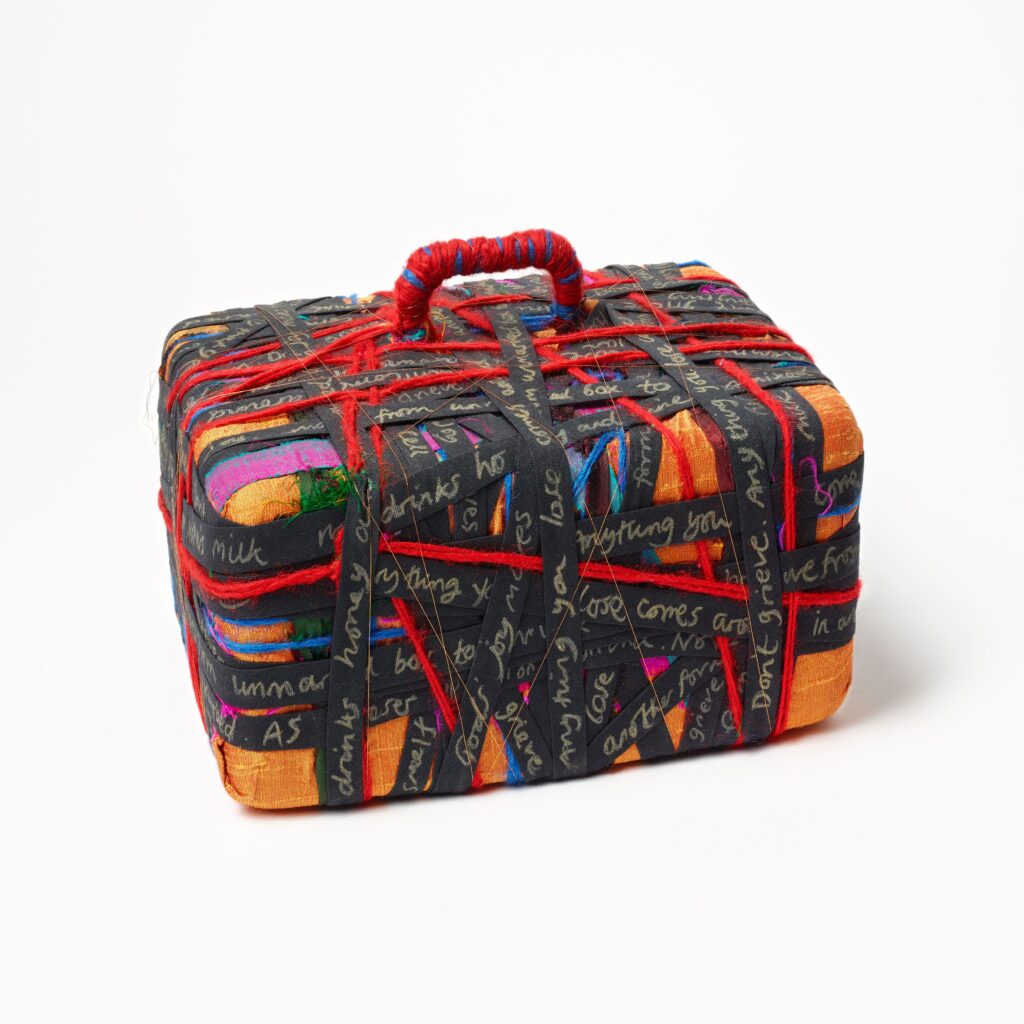
In 2016, I was asked to write and perform the stories behind a few of these sculptures which were on national tour as part of Tall Tales, and at the same time I was experimenting with interactive writing as part of an artist residency at Blast Theory and beginning to discover writing in a sensory, immersive way. As I unravelled the life events, political crises, ancestral memories and family secrets behind my sculptures and installations and found myself drifting into dream, magic realism and Iranian history, a series of stories which formed a poetic chronicle of my mother’s life and death started to emerge.
In 2017, with the support of a TLC Free Reads bursary via New Writing South, I was encouraged to keep writing these stories until I had a complete collection. By 2019, spurred on by the fact that two of my stories were being published in the Hidden Sussex anthology, and with the excellent editorial mentoring of Sharon Duggal at New Writing South, I finally realised that I was writing a book. She supported me, over 6 months of this last winter and spring, in turning my first draft collection of stories into a completed 5th draft of a coherent novel, an unexpected outcome. And now it’s ready to send out into the world. A very changed world.
I’m aware I was very privileged; I was only able to dedicate this intensive time to my writing and the projects that came from it, through mentoring via an AN Artist’s Bursary, followed by an Arts Council Research and Development (R+D) grant, which I applied for last summer to develop a project bringing these intimate stories to life within my more public, performative, social arts practice. But there was a fork in the path; the stories evolved into a self -contained work, a fiction novel based on real events, and, in parallel, I proposed to create a live work which offered listeners and readers a different kind of agency and engagement with my book’s themes of belonging, trans-cultural identity, and the small treasures that eventually emerge from multiple life losses. I also wanted to impart an experience of the fragility and risk within the earth itself, through climate change, which had taken my mother – and thousands of others – away.
My first collective activity at the start of my R+D was a Speculative Fiction (SF) workshop for BAME/PoC writers at New Writing South, set up by Inscribe/Peepal Tree Press via writer Akila Richards, as a feeder for a new SF anthology, edited by the writer Leone Ross. I hadn’t heard of SF before, which is defined by Inscribe as an ‘umbrella term, including multiple genres, (science fiction, magical realism, futurism, dystopia) where the writer speculates on or imagines what is not presently real or possible’. I opened up Leone Ross’ book, Come Let us Sing Anyway, on a rainy Saturday, and didn’t move for six hours. Reading this collection of incredible short stories, without stopping, so hungry was I for more, was a life changing moment – like a crack opening up in a portal to another world, which was fully open and blazing by the end of the workshop that autumn. It was run by the inspirational and effervescent Ronnie McGrath, who took us from the roots of speculative fiction in afro-futurism and black power movements, introducing us to seminal SF writers such as Octavia Butler and Henry Dumas, to offering us the SF genre as a powerful tool, for positing, dreaming into existence – and reclaiming – a different kind of world. It was the first time I was challenged to write anything outside of immediate reference to my own autobiography. During the writing ‘character’ exercise, I found myself writing someone who I loathed, a corrupt and disgusting man consumed by power in a fascist theological republic – and discovered that I could write fiction. That is, I could dare to write fiction. I had just needed permission to try.
My next thought was, if I can write from a point of view of a human who is not me, I can perhaps write from the non-human perspective too. And that, along with time spent on the downs and by the coast, is how I came to write this new piece, We See You Now.
Alongside my novel manuscript, which ends on the cliffs at Birling Gap (part of the Seven Sisters in the South Downs National Park), I had all kinds of questions emerging:
What kind of stories might I start to tell once this novel was completely finished? What purpose does an individual’s story serve beyond its own telling, especially during times of crisis – both in health, environment and our collective identities? Where are we all heading, as the edges of this island – and all that we have known – rapidly erode? In the shambolic midst of the post-Brexit haze, I also wondered; what does belonging here in the UK actually mean? Why do I still feel culturally marginal when I was born here and have lived here most of my life? And what happens when we are cut adrift from the mainland, from Europe, from a part of our broader identity (and that I know I, as someone who spent my twenties living in Paris, so took for granted)?
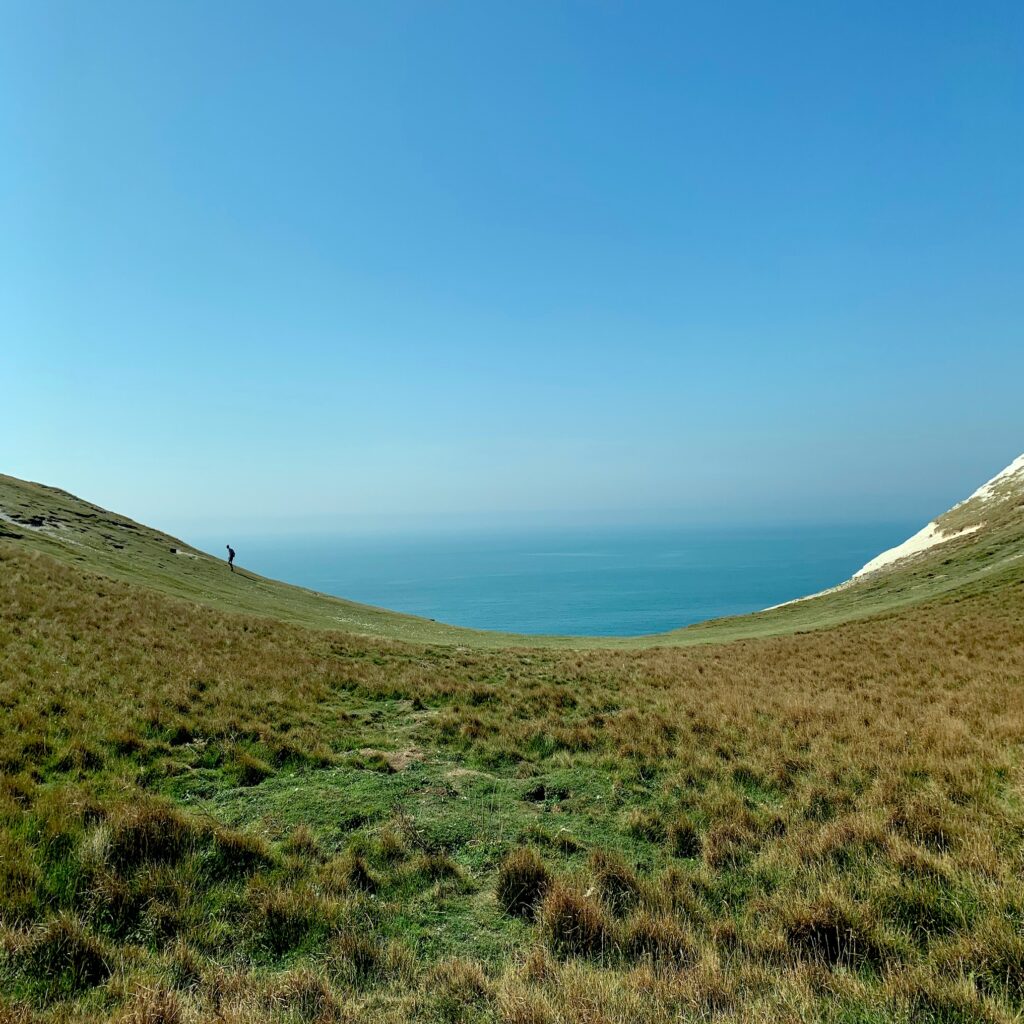
Birling Gap, the trigger for We See You Now, is a place of extremely personal resonance for me. It’s where, at her request, we cast our mother’s ashes a year after her death at sea, and is also close to Eastbourne, the coastal town she first arrived in on her migration to this country in 1965, from pre-revolutionary Iran (when Iranians were openly welcome, rather than, as is increasingly the case now, smuggled in on boats or thrown into detention centres.)
The piece is based on a poem I wrote inspired by the chalk cliffs there, after a visit last late autumn. I walked, scribbled notes and then went into the visitor centre and was immediately struck by a thick, white line painted across the floor in front of me, slicing halfway across the space, marked ‘2053’. No-one working there could tell me what the plan might be for when the cliff edge and sea will have reached this point. I found myself focusing on our human fragility, on edges and on future horizons.
At the moment, enhanced by COVID, climate change and the intensifying inequalities around us, there are many people who feel both physical, emotional and mental fragility within themselves – and a certain degree of resilience at having made it this far. I am also aware of a heightened degree of human kindness and solidarity through this time. As intimacy with other human beings has become more complex to negociate and access, intimacy with nature is coming into focus. As part of my funded period, I wanted to create a space for all this to unravel and explore the themes of my text in a group, working on a small scale in a generative way, using it to trigger other discussion and writings. So I had factored in to run a writers retreat for 12 BAME/ PoC writers (or artists who use writing in their practice in some form).
Initially to be set between Birling Gap/East Dean and New Writing South, with copious outdoor experience, the in-person retreat was cancelled as we went into lockdown, but I went ahead – supported by producer Amy Zamarippa Solis (This Too Is Real) and partner organisation, Writing our Legacy – redesigning the retreat as a hybrid (zoom /offline) experience, and we each gathered from our homes together online in early May.
I had sent the writers a draft recording of We See You Now to set the thematic and as an initial, optional writing prompt. We focused the retreat on the nurture of the writer self, aware that lockdown and in some cases full quarantine, might be affecting the capacity of some to fully engage with the relationship to this part of themselves, and to keep writing. We sent participants (who safely could) out on walking journeys, shared our ancestral stories, our relationship to nature, where our ‘edges’ lie and what we are reaching for in the future through our writing, in this world of increasing precarity and risk. We used objects, photos, meditative time and ritual as well as our pens and laptops to craft new writing. I was struck by the power of everyone’s work and the insights and reflections on the rich intersections between identity, writing practice and well-being that emerged between us.
A strong sense of solidarity arose as we immersed ourselves in radical listening and pooled the very diverse strategies we all use to stay well, focused and active as writers and human beings, and we have also decided to start a writer’s group. The eyes and ears of these retreat writers on my text – so rich and diverse in their life experiences and craft – were also very affirming, to have the perspective of others with whom I had a level of commonality beyond the fact we all write, was crucial at that point. It helped me see why it all mattered.
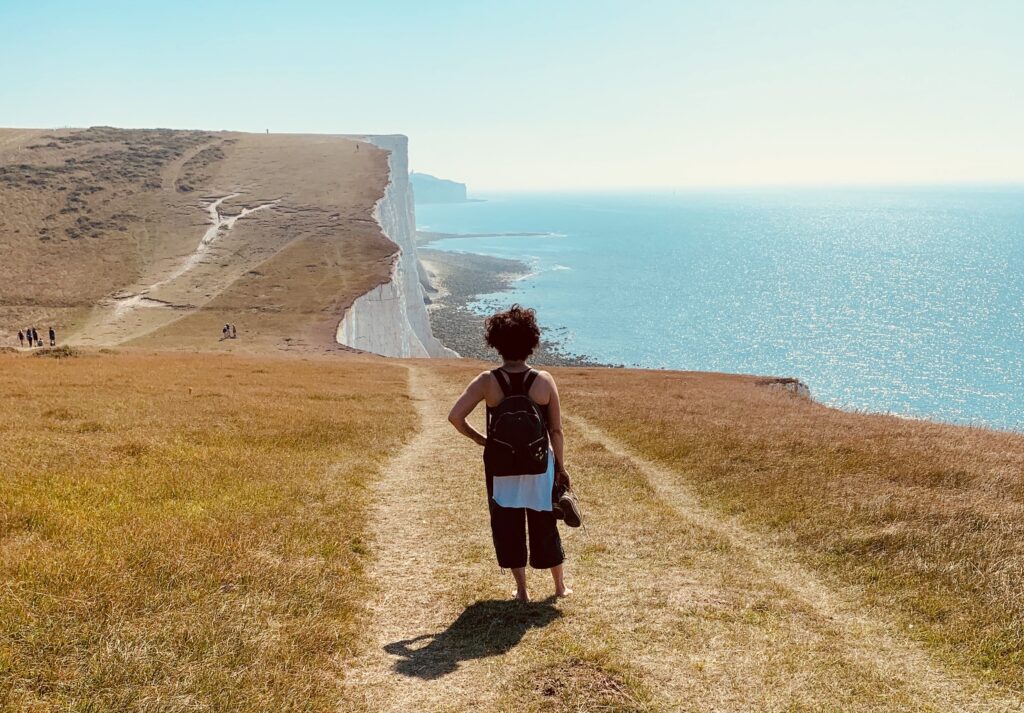
As I write, the lid is being lifted on the full horror of the impact of this COVID crisis on BAME/ PoC people across the world, not just in the increased risk to health, but to the exposure to racist violence, repression of human rights and access to resources and justice.
It has become clear to me why, alongside my own story, I was driven to create a piece of writing that invites others in, which attempts to catalyse, mobilise, and decolonise – through creating new myths and bringing stories into full view – that could become part of a process of reclaiming this shared land. A quiet but clear step on the ground of the national park, which we all live in reach of, and yet is still firmly connected, through many of us, with the red, yellow earth, sand and rock of a whole spectrum of territories from which we or our family or ancestors have chosen to leave, fled, or escaped. As one retreat writer said, ‘I now realise these are my hills, too’.
I walk on the downs a lot, it is on my doorstep. And I walk with the question; what role can writing, out in the landscape and in solidarity with others, play in disrupting this conundrum; why are there still so many of us, whose sense of identity and belonging is regularly thrown into question for reasons of race, gender, class, socio-economic factors, ableism, who do not feel that all parts of them can be safely seen, heard or valued and in full relationship with the land, sea, air of this island on which we all live?
We See You Now is a vision of radical hope that I dare to create.
Originally, pre-pandemic, this project was intended to become a live work, outdoors and perhaps later taking the form of an installation or audio work in a gallery. As someone writing across disciplines, I have been able to situate it in the intimate space of an audio work, which you can take with you on headphones out, near the water’s edge if you are safely able to, with a notebook and pen, or just listen from home. It is both a story in itself and it is a prologue.
I see it, and many other future myths like it, embedded at points across the downs, humming inside people’s heads and burying themselves in their consciousnesses as stories rooted in heritages that were always there, an evolving anthology perhaps, growing organically along the coast, the fruits of further retreats and a network of artist/writers who themselves would become the facilitators of this decolonising process. And then, one day, when mass assembly in a reflective, at ease way, is feasible, bringing together all those who have been part of or touched by the project, in sight of the water’s edge, to enact together what happens at the end of the story you will hear.
This particular story stands alone, but it doesn’t need to. Which is how I feel about my own life and work; I enjoy the solitude of writing, but I don’t feel I write in isolation. I am aware that we are all at a crossroads, where choosing to walk – and write – in solidarity with others holds us far more firmly on the path towards a freer and more hopeful world.
In the meantime, I intend to keep writing, walking and holding space and I am learning to live with not knowing what comes next, trusting that the right next step reveals itself in this unprecedented time of shifting paradigms, polarised ideaologies and crumbling realities as we edge closer to our collective cliff edge – and the potential power and beauty which arises beyond it.
We See You Now is now live online as part of Birkbeck Arts Week 2020.
A second We See You Now retreat for 12 BAME/ PoC writers will take place August 8/9th In partnership with Writing our Legacy and is free / by donation. To enquire about a place, please contact producer Amy Zamarippa Solis or see info here.
Alinah Azadeh is a writer, artist, performer and social activist of British Iranian heritage. She has been creating visual and live works for museums, galleries and across diverse communities for over 20 years and has had short stories, interviews and articles published in print and online, most recently in the Hidden Sussex anthology (2019). She has just finished writing her first novel.
